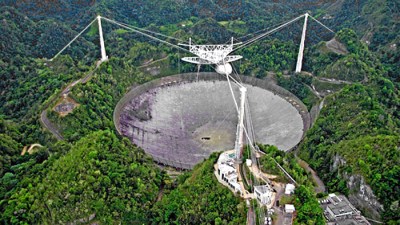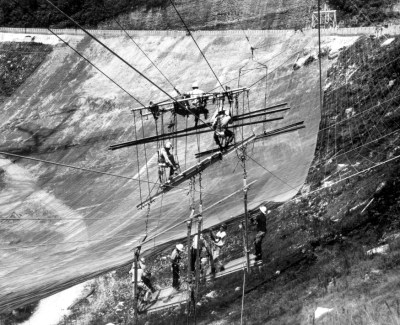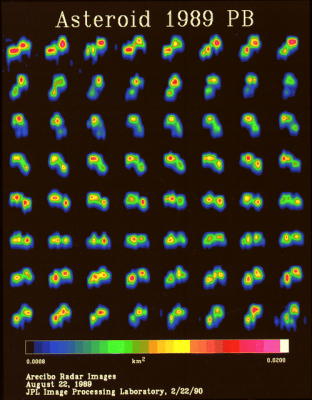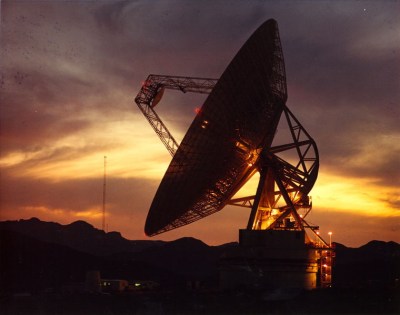In the early morning hours of April 10th, a support cable at the Arecibo Observatory pulled lose from its mount and crashed through the face of the primary reflector below. Images taken from below the iconic 305 meter dish, made famous by films such as Contact and GoldenEye, show an incredible amount of damage. The section of thick cable, estimated to weigh in at around 6,000 kilograms (13,000 pounds), had little difficulty tearing through the reflector’s thin mesh construction.
Worse still, the cable also struck the so-called “Gregorian dome”, the structure suspended over the dish where the sensitive instruments are mounted. At the time of this writing it’s still unclear as to whether or not any of that instrumentation has been damaged, though NASA at least has said that the equipment they operate inside the dome appears to have survived unscathed. At the very least, the damage to the dome structure itself will need to be addressed before the Observatory can resume normal operations.

It’s far too early to know how much time and money it will take to get Arecibo Observatory back up to operational status, but with the current world situation, it seems likely the telescope will be out of commission for at least the rest of the year. Given the fact that repairs from the 2017 damage still haven’t been completed, perhaps even longer than that. In the meantime, astronomers around the globe are left without this wholly unique resource.
A Cold War Relic
It might not be immediately obvious why the loss of Arecibo might be such a problem. After all, it’s just a radio telescope. It’s not even the largest one anymore, as that title was taken from it in 2016 by the Five hundred meter Aperture Spherical Telescope (FAST) in China. Surely researchers could shuffle their experiments over to other observatories?
In some cases, they likely will. But the Arecibo Observatory has a special feature that makes it unique among all of the large radio telescopes in the world. It can do something that even the much more modern FAST isn’t capable of: it has the ability to transmit, where the others can only serve as receivers. This lets Arecibo perform radar astronomy, by transmitting microwaves and observing how they reflect off of distant objects.

Normally, transmitting is not something a radio telescope would ever be expected to do. No more than an optical telescope would be expected to project light into the sky. But the Arecibo Observatory wasn’t actually designed as a radio telescope to begin with, at least, not primarily. Its original goal was to help detect nuclear intercontinental ballistics missiles launched from the Soviet Union.
In the late 1950s, the Advanced Research Projects Agency (now known as DARPA) started looking into ways to detect incoming ICBMs as they reentered the Earth’s atmosphere. It was generally understood that a object traveling at reentry speeds through the atmosphere would leave a ionized trail in its wake, and that further, this would show up as a distinctive radar signature. But there was little hard data on the subject, and even less was known about the region of the upper atmosphere known as the ionosphere.
To help fill in these gaps, and hopefully produce a reliable way of detecting and tracking potential ICBM warheads, a contract between Cornell University and the ARPA led to the construction of what was then called the Arecibo Ionospheric Observatory in 1963. By sending powerful radar transmissions into the ionosphere and studying the returning echo, the installation would be able to study electromagnetic interactions at the wispy edges of the atmosphere.
Reaching for the Stars
The field of radio astronomy was still in its infancy when the dish was built, but it didn’t take long before the true scientific value of Arecibo became apparent. The study of the ionosphere certainly had value, but the sensitive equipment at the observatory could see much farther than that. Within a decade of coming online, data from the dish was able to confirm the existence of neutron stars and identify the first binary pulsar.

The installation’s ability to transmit signals into deep space also held tantalizing possibilities. In 1974 researchers broadcast what has come to be called the Arecibo Message towards the star cluster M13. This 210 byte burst of digital information included simple images of the human form and the radio telescope itself.
It represented the first, and to date only, concerted attempt to directly communicate with potential extraterrestrial life. The composers of the message, which included Frank Drake and Carl Sagan, didn’t really expect a reply; but the fact that humanity was capable of sending it in the first place was seen as a technological turning point.
In 1989, Arecibo was able to capture the first direct images of an asteroid in space. Usually asteroids are too far away and too small to be more than a spec of light through an optical telescope, but when viewed by radar, the shape and rotation of Castalia could be observed easily.
Data collected by the dish in 1990 would later be used to confirm for the first time the existence of planets outside of our own solar system. We now know there to be thousands of these so-called exoplanets, and more are still being discovered thanks to dedicated planet-hunting spacecraft that owe their origins to Arecibo.
An Uncertain Future
To this day, the Arecibo Observatory remains the largest and most powerful deep space transmitter in the world. The radar images it’s able to generate of distant objects is absolutely unparalleled, even 60 years after its construction. More than just satisfying our curiosity about the cosmos, this capability makes it an important part of NASA’s Planetary Defense program. We’re already leaning heavily on antiquated orbital assets to help identify and track potentially dangerous asteroids as they approach the Earth, losing the one-of-a-kind radar capabilities of Arecibo is only making a bad situation even worse.

Until Arecibo Observatory is able to come back online, our closest thing to a backup is the Goldstone Deep Space Communications Complex in California. Rather than one huge dish, it’s made up of five independent antennas, the largest of which is less than 1/4 the diameter of the primary reflector at Arecibo.
While not nearly as sensitive, the multiple antennas do have the advantage in that they can each be aimed at a separate targets. That’s because Goldstone is primarily tasked with maintaining communications with distant spacecraft, often several at a time. The antennas can be used as radio telescopes, but only when they aren’t actively engaged in spacecraft communications. That limited research time just got even more valuable with the influx of former Arecibo researchers who will be vying for time on the equipment.
The reality is, much of the research that was being conducted at the Arecibo Observatory will have to be put on hold for the time being. There’s no direct replacement for the radio telescope’s unique set of abilities, and the available research time on lesser installations won’t be sufficient to cover the increased demand. Still, the clear scientific need to get the Observatory back online doesn’t automatically make the logistics of making it happen any easier. At least for the time being, humanity’s ability to peer into the cosmos will be a bit more limited than what we’ve become accustomed to.
via Radio Hacks – Hackaday https://ift.tt/3hBA1ve
No comments:
Post a Comment